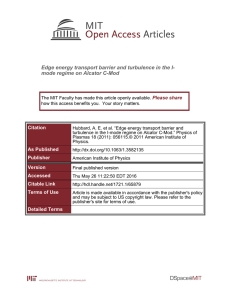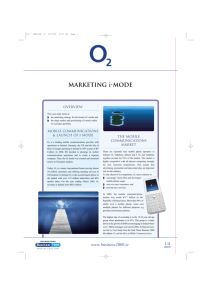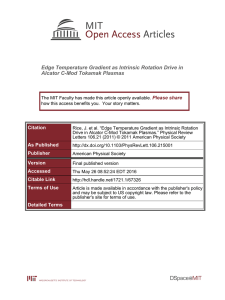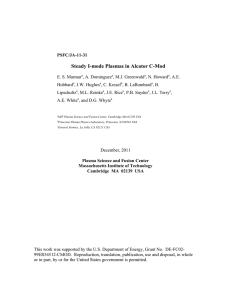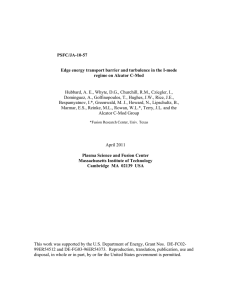Heat-flux footprints for I-mode and EDA H-mode plasmas on Alcator C-Mod
advertisement
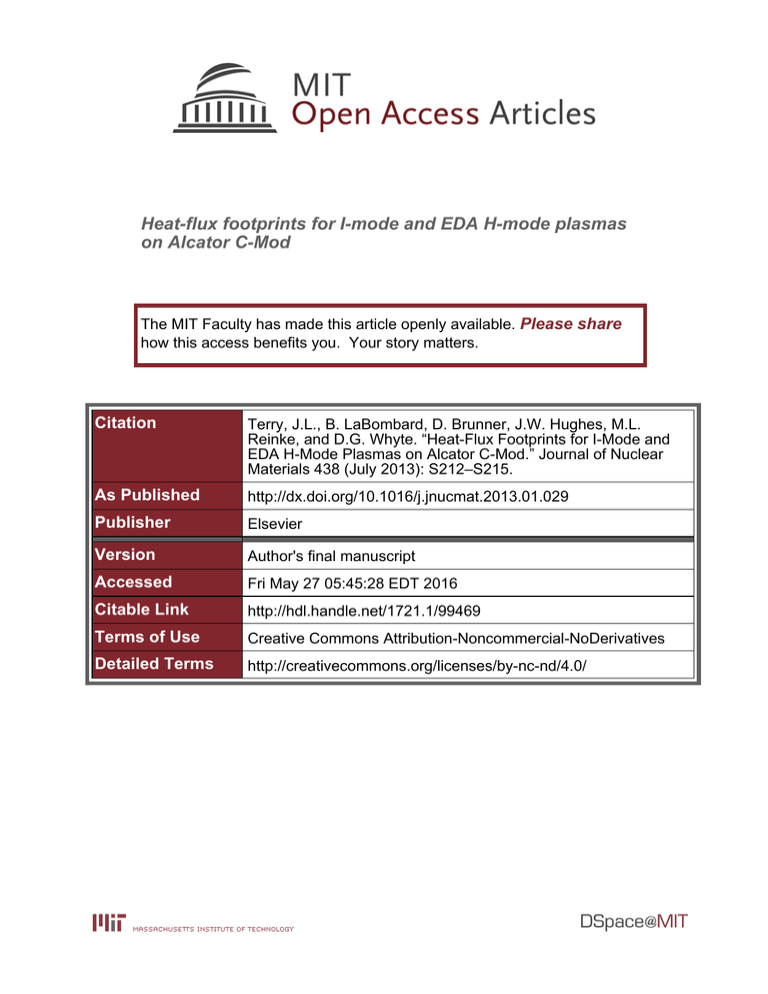
Heat-flux footprints for I-mode and EDA H-mode plasmas
on Alcator C-Mod
The MIT Faculty has made this article openly available. Please share
how this access benefits you. Your story matters.
Citation
Terry, J.L., B. LaBombard, D. Brunner, J.W. Hughes, M.L.
Reinke, and D.G. Whyte. “Heat-Flux Footprints for I-Mode and
EDA H-Mode Plasmas on Alcator C-Mod.” Journal of Nuclear
Materials 438 (July 2013): S212–S215.
As Published
http://dx.doi.org/10.1016/j.jnucmat.2013.01.029
Publisher
Elsevier
Version
Author's final manuscript
Accessed
Fri May 27 05:45:28 EDT 2016
Citable Link
http://hdl.handle.net/1721.1/99469
Terms of Use
Creative Commons Attribution-Noncommercial-NoDerivatives
Detailed Terms
http://creativecommons.org/licenses/by-nc-nd/4.0/
PSFC/JA-12-37
Heat-flux footprints for I-mode and
EDA H-mode plasmas on Alcator C-Mod
J.L. Terry, B. LaBombard, D. Brunner, J. W. Hughes,
M.L. Reinke, and D.G. Whyte
November 2012
Plasma Science and Fusion Center
Massachusetts Institute of Technology
Cambridge MA 02139 USA
This work was supported by the U.S. Department of Energy Coop.
Agreement DE-FC02-99-ER54512. Reproduction, translation, publication,
use and disposal, in whole or in part, by or for the United States
government is permitted.
Submitted for publication to the Journal of Nuclear Materials.
Heat-flux footprints for I-mode and EDA H-mode plasmas on Alcator
C-Mod
J.L. Terry*, B. LaBombard, D. Brunner, J. W. Hughes, M.L. Reinke, and D.G. Whyte
Plasma Science and Fusion Center, MIT, Cambridge, MA, USA 02139
Abstract
IR thermography is used to measure the heat flux footprints on C-Mod’s outer target in Imode and EDA H-mode plasmas. The footprint profiles are fit to a function with a simple
physical interpretation. The fit parameter that is sensitive to the power decay length into the
SOL, λSOL, is ~1-3x larger in I-modes than in H-modes at similar plasma current, which is the
dominant dependence for the H-mode λSOL. In contrast, the fit parameter sensitive to transport
into the private-flux-zone along the divertor leg is somewhat smaller in I-mode than in Hmode, but otherwise displays no obvious dependence on Ip, Bt, or stored energy. A third
measure of the footprint width, the “integral width”, is not significantly different between Hand I-modes. Also discussed are significant differences in the global power flows of the Hmodes with “favorable” "B drift direction and those of the I-modes with “unfavorable” "B
drift direction.
!
!
PACS: 52.55.Rk, 52.55.Fa, 52.25Fi, 52.70.Kz
*Corresponding Author Address: 175 Albany St., Cambridge, MA 02319 USA
*Corresponding Author E-mail: terry@psfc.mit.edu
Presenting Author: James L. Terry
Presenting Author E-mail: terry@psfc.mit.edu
1
I. Introduction
Acceptable power handling is one of the primary functions - and most challenging problems for a tokamak divertor. Recent work [1-6] has focused on measurements of the heat-flux
“footprints” on divertor surfaces and heat-flux widths during H-mode confinement in various
tokamaks (Alcator C-Mod, AUG, DIII-D, JET, and NSTX). This interest is due in large part
to the desire to understand the physics that sets the heat-flux widths and to predict them in
ITER [2, 5, 7, 6], since they will play a crucial role in determining the difficulty of an
acceptable solution for power handling in the ITER divertor. These multi-machine studies
indicate that the width scales inversely with the poloidal field strength, Bpol, which when
extrapolated to ITER yields a ~1mm width [2, 5, 6]. Widths this small would substantially
increase the difficulty of finding a divertor solution. Similar width values are obtained when
the heuristic, drift-based model of [7] is extrapolated to ITER. Whether such a small width
can be sustained on ITER is without violating other constraints is currently being studied [8].
IR thermography was used as the common measurement technique on these different
devices, and the resulting footprints are being fit to functions of the same form so that
differences can be compared directly [5, 6]. An especially useful functional form that has
valuable physical interpretation has been recently proposed by Eich [2] and is now being
used for multi-machine comparisons. This form fits the heat-flux footprints to a function that
yields a measure of the perpendicular transport into the common-flux region, λSOL (the λq
parameter in [2]), as well as a measure of the transport into the private flux zone (PFZ) along
the outer leg of the divertor, wPFZ (the S parameter in [2]). Another measure of more direct
relevance to the power handling requirement is the integral power width [9], λInt, which
relates
the
peak
heat
load
to
the
total
power
incident
on
the
target,
i.e.
, where f is the midplane-to-divertor magnetic flux
2
expansion. In this work, these measures have been used to parameterize footprints from CMod’s Enhanced-D-Alpha (EDA) H-mode and I-mode plasmas.
The I-mode plasmas are of particular interest because of their attractive confinement
features [10, 11] and because the edge heat and particle transport are more de-coupled than in
H-mode, allowing for a large temperature pedestal and high energy-confinement (H98<1.2)
without a density pedestal and without ELMs regulating the edge pressure. Thus the edge
profile gradient-scale-lengths for Te are similar in I-mode and H-mode, while the edge
gradient-scale-lengths for ne are different, with LneI-mode, ped ~ 10xLneH-mode,ped [10]. We compare
the I-mode and H-mode heat-flux footprints, both as part of the evaluation of the I-mode
regime and for insight into the physics of what determines the widths. Because characteristics
of the I-mode confinement regime are not necessarily widely known, we list three additional
characteristics to supplement those just mentioned: 1) I-modes are typically obtained in the
“unfavorable” "B drift configuration, so as to stay below the H-mode power threshold and
obtain the widest “power window” for maintaining I-mode (to date I-modes have been
!
sustained at powers ~1.8x the L-to-I-mode threshold); 2) I-mode is stationary, having been
maintained on C-Mod with steady conditions for >10 energy confinement times, and 3) to
date, I-mode confinement scales roughly as Pin-0.3, i.e. it falls less strongly with power than for
H- and L-mode.
II. Experimental details and analyses
Alcator C-Mod is a compact high field tokamak that uses auxiliary ICRF heating. At the
bottom of the device is a closed divertor with solid Mo tile targets which receive parallel
heat-fluxes up to ~500 MW/m2. Heat-flux measurements are made on an instrumented
section of the outer target of that closed divertor. Imaging IR thermography, calibrated after
each shot using embedded thermocouples, is used in the high heat flux cases of interest here
to measure the time-histories of surface temperature profiles. These measurements, combined
3
with the poloidal and radial geometry and thermal properties of the Mo target tiles, are
analyzed to produce profiles of heat flux incident on the tiles using the 2D heat flux code
QFLUX2D. The thermography and heat flux code are described in more detail in [12, 4]. A
typical heat flux profile from an I-mode plasma is shown in Fig.1. Of note are: 1) the
abscissa, ρ, is the distance outside the Last
measured
Eich fit
Eich fit w small λSOL
400
300
200
100
0
w
λSOL
PFZ
0
5
ρ (mm)
10
Closed
1110215012: t=[1.255,1.285]: FWHMe=0.97, λe=1.38 mm
parallel heat-flux (MW/m2)
500
Flux
Surface
(LCFS)
when
magnetically-mapped from the target to the
outboard midplane1, 2) the ordinate is the
parallel heat-flux at a given ρ as inferred
using knowledge of the surface heat flux and
field line angle of incidence, 3) the peak
values of q|| are typically ~200-500 MW/m2 in
Figure 1. (color online) Typical parallel heat
flux profile on the outer target from an I-mode
plasma. The profile has been magnetically
mapped to the outboard midplane and shifted
by 1.6 mm from the EFIT value in order to
align the peak with ρ=0. The Eich fit to the
profile (λSOL=1.38 mm, wPFZ=0.58 mm) is
shown in red. The blue dashed curve shows the
effect of a small value of λSOL (0.1 mm) with
wPFZ held constant to still match the profile in
the PFZ. λSOL is used to describe the profile
fall-off in the common-flux region. The heatflux profile “tail” is a typical feature on CMod.
unseeded high performance plasmas, 4) there
is always a far-SOL “tail” in the profile with
roughly constant heat flux, and 5) the heat
flux decay into the PFZ is steeper than the
decay into the common SOL. In the case
shown, the peak in the target heat flux is not
perfectly aligned with the EFIT-located strike
point. We attribute that to errors in the equilibrium reconstruction of the strike-point location
and find that shifts of < 2mm typically bring the two into alignment.
Finally, there exist a few shots in which the strike-point was swept over operational
Langmuir probes and/or fast-response surface thermocouples [13], thereby allowing
comparison of the common-flux part of heat flux profiles measured in this way with those
1
PFZ regions, which do not map to the midplane, are assigned ρ values equal to the ρ value
of closed flux surfaces in the core plasma having the same value of poloidal flux.
4
measured using thermography. In those cases, the IR profile is somewhat broader than that
from the probe with essentially the same peak heat flux, while the IR profile is from 1-3x
broader than that inferred from the surface TC. The reasons for this are being investigated. In
this study only profiles from the IR thermography will be compared.
The target heat flux profiles are fit using a physics-based parameterization due to Eich
[2] that convolves a Gaussian with a decaying exponential function:
(Eq. 1)
where q||,0 is the peak parallel heat flux, qbkg is a “background” heat flux that will represent the
observed “tails”, λSOL describes the profile broadening due to perpendicular transport into the
SOL occurring before entering the divertor, and wPFZ represents the competition between
perpendicular and parallel transport that allows for the spreading of the footprint into the PFZ
along the outer divertor leg, s is the profile coordinate, defined such that the strike point
location is s=0. This parameterization is illustrated in Fig. 1 by the red and blue-dashed
curves, where the red curve is the best fit to the measured profile (λSOL=1.38 mm, wPFZ =0.58
mm), while the dashed curve, with the same wPFZ, but a much smaller λSOL, is used to
illustrate the fit to the PFZ profile and to show the need for a larger λSOL in order to follow the
fall-off of the measured profile in the common-flux region. We examine the scaling of these
heat-flux-profile-fitting parameters as well as the values of λInt in the next section.
III. Scaling of heat-flux footprints in EDA H-mode and in I-mode
1. EDA H-mode results
LaBombard, et al. [4] described the dependencies of C-Mod heat-flux widths in EDA Hmodes and Ohmic L-modes. These plasmas were made in a LSN configuration with the Bt
direction such that the
drift direction was favorable for H-mode (the “normal” direction).
For that work, target heat flux widths were characterized both by an e-folding length on the
5
, and by the FWHM of the main
common-flux side of the profile,
peak of the footprint,
. Those width parameters showed a
general decrease with increased stored energy. A Ip-1 dependence (also found in other
devices) was found for λEFOLD of plasmas selected for having high values of stored energy per
unit Ip. No significant dependencies were found in the λEFOLD, λInt, or FWHM measures for
power in the SOL (PSOL=Pin-Prad), Bt, or full connection length. For the present work, these
same discharges have been re-analyzed using the more elaborate Eich parameterization with
λSOL and wPFZ. Results vs Ip are shown in Fig. 2 as the blue triangles. The width dependence on
for the plasmas selected for high stored energy per
Ip is found to be in λSOL (roughly
unit Ip – Fig. 2a), while wPFZ shows no consistent dependence either on Ip (Fig. 2b), Bt, or
stored energy. Finally, the dependence of the integral width, λInt, vs Ip is shown in Fig. 3 for
the same discharges. In this important power-handling measure, the Ip dependence is much
reduced due to the combined effect of the profile “tail” and the Gaussian width, wPFZ.
2.0
1.5
wPFZ (mm)
λSOL (mm)
1.5
1.0
1.0
0.5
0.0
0.4
wPFZ
2.0
λSOL
~Ip-1
(a)
0.6
0.5
I-mode
I-mode w/o Ne
EDA H-mode
0.8
1.0
Ip (MA)
1.2
{
“instrumental” resolution
0.0
0.4
1.4
0.6
0.8
1.0
Ip (MA)
(b)
1.2
1.4
ds_EDA_Imode_v_Ip_max_wmhd
ds_EDA_Imode_v_Ip_max_wmhd
Max WMHD EDA only from Runs 1100212, 1100223, 1100224, 1100303, 1100310 & Imode shots from Runs 1110215,/home/terry/ir/ir_db/Lambda_Eich_EDA_L_I_v_Ip_maxW.ps
1110309, 1110316,
1110317
Max WMHD
EDA only from Runs 1100212, 1100223, 1100224, 1100303, 1100310 & Imode shots from Runs 1110215, 1110309,
/home/terry/ir/ir_db/FWHM_Eich_EDA_L_I_v_Ip_maxW.ps
1110316, 1110317
Figure 2. (color online) (a) Comparison of the values of the fit parameter λSOL vs Ip for the heat
flux profiles of EDA H-modes and I-modes. These points are from discharges selected for having
high thermal energy per unit Ip. (b) Comparison of the values of the fit parameter wPFZ vs Ip for the
same discharges. The blue band indicates the estimate for minimum resolution of the
measurement/analysis.
2. I-mode results
6
I-mode confinement discharges are more readily produced with the
drift in the
“unfavorable” direction since this raises the H-mode threshold and widens the power window
available for I-mode. In order to put the heat flux footprint onto the lower instrumented target
with unfavorable drift, “reversed” field is required. While this leads to quite different power
sharing between inboard and outboard targets (discussed below), it also means that there are
fewer I-mode LSN discharges and that the parameter space for which I-mode footprint data
exist is restricted compared that for H-mode. In particular, scans of Ip and Bt dedicated to
footprint measurements do not exist for I-mode; measurements exist only for the current
range 1.0 < Ip < 1.25 MA with 5.1 < |Bt| < 5.7 T. Nonetheless, the measure of the footprint
decay into the common SOL, λSOL, for I-modes is observed to be 1-3x larger when compared
to those of H-modes. This is apparent in Fig. 2a where λSOL values for the I-mode points are
compared with those of H-mode. The scatter in the values and the restricted Ip range for the Imodes make it impossible to discern any scaling of λSOL with Ip. The observation that λSOL is
similar to or larger in I-mode compared to H-mode is important for insight into the physics
8
λint
responsible for setting the width (Sect.
IV), but does not mean that the I-mode
λint (mm)
6
power handling requirements (relative to
4
2
H-mode) are reduced by the same factor.
~Ip-0.35
0
0.4
ds_EDA_Imode_v_Ip_max_wmhd
0.6
This is apparent when the integral widths,
I-mode
I-mode w/o Ne
EDA H-mode
0.8
1.0
Ip (MA)
1.2
λInt, are compared (Fig. 3); the values of
1.4
λInt in I-mode are not statistically different
s
Max WMHD EDA only from Runs 1100212, 1100223, 1100224, 1100303, 1100310 & Imode shots from Runs 1110215,/home/terry/ir/ir_db/IntLambda_I_EDA_L_v_Ip_at_maxW.p
1110309, 1110316, 1110317
Figure 3. (color online) Comparison of the
footprint “integral widths”, λInt, vs Ip for the
same EDA H-modes and I-modes of Fig. 2.
from those of the H-modes. The presence
of the profile “tail” and the somewhat
smaller I-mode values for wPFZ (Fig. 2b) reduce the effect of the larger λSOL width. As shown
in Fig. 2b, the average wPFZ for the I-mode points is ~20% smaller than that for H-mode. At
7
present we can only speculate about reasons for this difference, relating it to possible
differences in drifts due to the “reversed” field configuration of the I-mode discharges. It may
be related to whatever is causing differences in wPFZ found for different Asdex-Upgrade
divertor geometries [5]. On C-Mod, wPFZ exhibits no obvious dependence on Ip or stored
energy. Also shown in Fig. 2b is a shaded band that represents the “instrumental resolution”
for wPFZ, which we believe represents the system’s minimum resolution for wPFZ. (This has
been evaluated using actual thermography images that were run though the QFLUX2D
analysis.) Thus we believe that, except for possibly the lowest cases, the values of wPFZ
shown in Figs. 2b have a physics basis and not an instrumental one2.
We now examine the global “power-flow” characteristics of I-mode in more detail. The
range of input power was roughly the same in the I-mode and H-mode plasmas studied here.
However, because the impurity transport is L-mode-like in I-mode [10], the “main chamber”
power radiated from I-mode plasmas is typically significantly less than or at most similar to
that radiated from EDA H-modes (PradH-mode~1-3xPradI-mode), and the power conducted into the
SOL, PSOL, is typically larger in these I-mode plasmas. In fact we observe that roughly
PSOLI-mode~1-3xPSOLH-mode, which increases the divertor power-handling loads for I-mode
plasmas. For the “reversed-field” configuration of these I-modes, however, the power-sharing
between inner and outer targets is significantly changed [14] such that the inner target
receives roughly 1.5x to 3x times more shot-integrated energy than is received on the outer
target. For the “normal-field” H-modes in this study, the energy asymmetry is 1x to 2x
greater on the outer target. The end result of this set of differences between the H- and Imode “power-flows” and footprints is that the peak heat-fluxes on the outer target, as well as
the total powers on the outer target, are roughly the same for the plasmas compared here. The
2
This assumes that rapid strike-point oscillation from some unknown source or a stochastic
magnetic region associated with the x-point zone is not smearing the profile into the PFZ,
since that would not be accounted for in the “instrumental resolution” estimate.
8
peak heat fluxes are shown in Fig. 4. However, this is not true for the inner target, where
power handling is a much bigger issue in these I-modes. Indeed, small amounts of neon were
seeded into all but one of these I-modes in order to reduce target heat loads. Low-Z impurity
peak q|| (MW/m2)
500
400
seeding into I-modes is far better tolerated
peak
q||
by I-modes (i.e. is without significant
negative effects) as compared to seeding
300
into H-modes because of the L-mode-like
200
impurity confinement of I-mode.
I-mode
I-mode w/o Ne
EDA H-mode
100
0
0.4
0.6
0.8
1.0
Ip (MA)
1.2
Another I-mode/H-mode difference is
1.4
Figure 4. (color online) Comparison of the outer
target’s peak parallel heat flux, q||peak, vs Ip for the
same EDA H-modes and I-modes of Fig. 2.
significantly lower collisionality in the Imode. This results in “sheath-limited”
conditions at the inner and outer targets in
I-mode, compared to “high-recycling”
conditions at the outer target in H-mode. Additionally, the parallel power flow in the I-mode
SOL is most likely “flux-limited”[15], with ν*e,SOL=L||/λee=5-50 << that of C-Mod’s H-modes.
Finally, for completeness, we have examined whether the low-Z impurity seeding used in
most of the I-mode plasmas might cause a systematic broadening of the profile and might
result in larger values for λSOL in the I-mode cases. While we cannot unequivocally eliminate
this possibility, we believe it to be highly unlikely since 1) λSOL for the single non-seeded Imode is not significantly different than λSOL for the seeded I-modes, 2) the outer divertor was
sheath-limited and fully attached in all I-modes, 3) (as mentioned above) the total radiated
power was similar or smaller in the I-mode plasmas, and 4) the powers on the outer target
were in the same range, 0.5<Podiv<1.3 MW for the H-modes and I-modes considered here.
IV. Discussion
9
MA is ~1-3x larger than in EDA H-
We have found that λSOL in I-modes with
mode at Ip ~1MA. The obvious question is: what is different about the I-mode plasmas that
would result in SOL heat flux widths that are larger than in H-modes? We hypothesize that it
is related to whatever relaxes the density pedestal in I-mode. As mentioned previously, the
tight coupling between particle and energy transport in the H-mode pedestal is much reduced
in I-mode, since its edge density profiles are L-mode-like. Previous work on footprint widths
of C-Mod’s Ohmic L-modes[4] showed a clear correlation between the pressure decay length
in the upstream SOL, LnTe, and the heat-flux width, both scaling as Ip-1. The new I-mode
observations are qualitatively consistent with this picture since LnTe is increased in I-mode as
compared to H-mode. Further quantitative comparisons of LnTe and λSOL require a detailed
analysis of the upstream scale-lengths of Te, Ti and ne, an analysis that is outside the scope of
this paper.
In summary, we find that, for EDA H-modes with the high stored energy per unit Ip, λSOL
values for footprints magnetically mapped to the midplane are in the 0.5-1.7 mm range and
exhibit an approximate inverse scaling with Ip. In the I-modes studied, λSOL ~0.8-2 mm for
MA and is ~1-3x the H-mode values in plasmas in a similar current range. This
difference is qualitatively consistent with the correlation of λSOL with upstream pressure decay
length that was found for Ohmic L-modes in C-Mod [4]. In contrast, the integral width, λint,
shows no significant difference between I- and H-modes The wPFZ parameter appears to vary
between (normal-field-direction) H-mode and (reversed-field-direction) I-mode plasmas, but
shows no obvious dependence either on plasma current or stored energy, with values ranging
between 0.6 and 1.5 mm in C-Mod.
10
Acknowledgement
We would like to acknowledge valuable discussions with Thomas Eich of IPP Garching and
Michael Makowski at GA (DIII-D). This work is supported by DoE Coop. Agreement DEFC02-99-ER54512.
References
[1] Ahn, J.W., Maingi, R., Boedo, J.A., and Soukhanovskii, V., Journal of Nuclear Materials
390-391 (2009) 421.
[2] Eich, T., et al., Physical Review Letters 107 (2011) 215001.
[3] Eich, T., et al., Journal of Nuclear Materials 415 (2011) S856.
[4] LaBombard, B., et al., Physics of Plasmas 18 (2011) 056104.
[5] Eich, T., this conference (paper I7) (2012.
[6] Makowski, M.A., et al., Physics of Plasmas 19 (2012) 056122 (9 pp.).
[7] Goldston, R.J., Nuclear Fusion 52 (2012) 013009 (7 pp.).
[8] Whyte, D.G., this conference (paper P1-037) (2012.
[9] Loarte, A., et al., Journal of Nuclear Materials 266-269 (1999) 587.
[10] Whyte, D.G., et al., Nuclear Fusion 50 (2010) 105005 (11 pp.).
[11] Hubbard, A.E., et al., Physics of Plasmas 18 (2011) 056115 (9 pp.).
[12] Terry, J.L., Labombard, B., Brunner, D., Payne, J., and Wurden, G.A., Review of
Scientific Instruments 81 (2010) 10E513 (4 pp.).
[13] Brunner, D. and LaBombard, B., Review of Scientific Instruments 83 (2012) 033501.
[14] Pitts, R.A., et al., Journal of Nuclear Materials 337-339 (2005) 146.
[15] Stangeby, P.C., Canik, J.M., and Whyte, D.G., Nuclear Fusion 50 (2010) 125003 (12
pp.).
11





